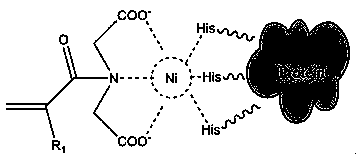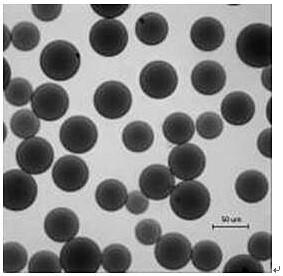A kind of preparation method of protein affinity imprinted hydrogel polymer based on acrylamide group metal chelating monomer
A hydrogel polymer and acrylamide technology, applied in the field of molecularly imprinted polymers, can solve problems such as difficult adsorption and desorption, slow mass transfer process of template molecules, and weak ion exchange force
- Summary
- Abstract
- Description
- Claims
- Application Information
AI Technical Summary
Problems solved by technology
Method used
Image
Examples
Embodiment 1
[0046] In a 2L four-necked round-bottomed flask equipped with a stirring paddle, a thermometer, a condenser tube and a feeding port, add 200ml of chloroform, add 50g of ethyl methacrylate and 0.5 mole of biaminodiacetic acid and stir to mix, add 1.8g React with anhydrous potassium hydroxide, slowly raise the temperature to 80°C, and react at this temperature for 3 hours, distill under reduced pressure to remove the unreacted ethyl methacrylate and the reaction product ethanol, and then add 1mol / l NaOH dropwise Adjust the pH to 10 and transfer to a 500ml separatory funnel. Add 100ml of chloroform to the separatory funnel, shake it, let it stand for stratification, remove the upper aqueous solution, and dry it under reduced pressure on a rotary evaporator to obtain 85.3g of a white product, which is the monomer methyl of the acrylamide family that can chelate with metal ions. Sodium Acrylaminodiacetate.
Embodiment 2
[0048] In a 2L four-necked round-bottomed flask equipped with a stirring paddle, a thermometer, a condenser tube and a feeding port, add 200ml of chloroform, 100g of methacryloyl chloride and 0.5 molar ratio of aminotriacetic acid and stir to mix, add 5g of anhydrous hydrogen Potassium oxide was reacted, and the temperature was slowly increased to 60°C. After reacting at this temperature for 6 hours, the unreacted methacryloyl chloride and the reaction product ethanol were distilled off under reduced pressure, and then 1mol / l NaOH was added dropwise to adjust the pH to 10 , transferred to a 500ml separatory funnel. Add 180ml of chloroform to the separatory funnel, shake it, let it stand for stratification, remove the upper aqueous solution, and dry it under reduced pressure on a rotary evaporator to obtain 152.6g of a white product, which is a monomeric methyl compound of the acrylamide family that can be chelated with metal ions. Sodium Acrylaminotriacetate.
Embodiment 3
[0050] (1) Synthesis of bovine serum albumin-imprinted hydrogel polymer (MIP)
[0051] A) In the aqueous medium, add 60 mmoL of sodium methacrylate aminooxalate, a monomer of acrylamide family that can chelate metal ions, add 10 mmoL of nickel sulfate while stirring slowly, and continue stirring for 30 min to form a stable complex. compound;
[0052] B) then add the bovine serum albumin BSA powder of 200mg, continue stirring to make it fully dissolve;
[0053] C) Then add 30 mmol of cross-linking agent N,N'2 methylenebisacrylamide, 100 mg of initiator ammonium persulfate and 20 mg of emulsifier Tween 80.
[0054] D) Molecular imprinting was carried out by reverse-phase suspension cross-linking method, and the above-mentioned aqueous phase imprinting system was prepared into W / O water-in-oil emulsion droplets. The specific method is as follows: add the above aqueous phase solution to the reverse suspension medium composed of chloroform, n-hexane and Span 80, the volume ratio ...
PUM
| Property | Measurement | Unit |
|---|---|---|
| particle diameter | aaaaa | aaaaa |
| particle diameter | aaaaa | aaaaa |
| particle size | aaaaa | aaaaa |
Abstract
Description
Claims
Application Information
 Login to View More
Login to View More - R&D
- Intellectual Property
- Life Sciences
- Materials
- Tech Scout
- Unparalleled Data Quality
- Higher Quality Content
- 60% Fewer Hallucinations
Browse by: Latest US Patents, China's latest patents, Technical Efficacy Thesaurus, Application Domain, Technology Topic, Popular Technical Reports.
© 2025 PatSnap. All rights reserved.Legal|Privacy policy|Modern Slavery Act Transparency Statement|Sitemap|About US| Contact US: help@patsnap.com



